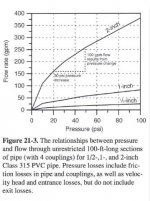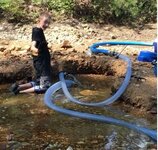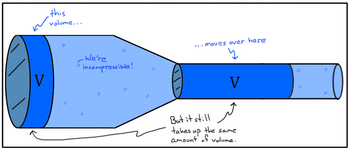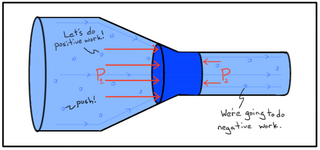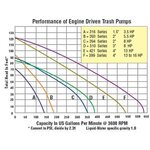I have a 2 inch dredge / high banker combo I put together. it is a keene a 52 sluice with a jobe 2 inch highbanker / dredge hopper. The sluice has a jobe stand it sits on as well. I'm using a jobe suction nozzle that has a 1.25 inch pressure hose and a 2 inch suction hose. I have 20 ft of 1.25" pressure hose. 20 ft of 2" suction hose and about 6 ft of 2 inch for the pickup hose. I have a jobe footvalve and made sure I primed the pump so there was no air in the foot valve. I'm running a 3 horse predator engine with a pump that's supposed to be 325 gallons per minute. it has a 2 inch cam lock and 2 reducers the first is 2 to 1.5 and then another one that's 1 to 1.25. when I first cranked the pump on it was pumping but just a slow trickle was coming out of the sluice. it was slightly leaking a small amount of water in between the pump and the engine..the pressure hose ended up coming loose and popped off the nozzle.. it had good pressure..it blew water about 15 feet and almost shot out of my hand. I turned the pump off and reattached it but still couldn't get it to pump enough to vacuum. I moved the sluice and pump and repositioned everything so the pump was upriver pumping downward to the nozzle and then the sluice sat further down river..still nothing..after a few hours of messing with it, it quit picking up water and pumping all together..am I using too much hose? or maybe a bad seal? and possibly bad plastic reducers? I'm not sure what brand pump but ive seen videos of the same one running a 4 inch dredge and he claimed it was only half throttle. I cant find the exact pump I have but here is a smaller version..it says its 200 gallon per minute 2 inch inlet with 1 and 1/2 inch discharge..mine was a 2 inch inlet with 2 inch discharge that was supposed to be 325 gallon per minute. It was built by the same guy. .backwoodz prospecting..
Gold Dredge Motor & Pump High pressure 200GPM FREE SHIPPING IN THE LOWER 48
Gold Dredge Motor & Pump High pressure 200GPM FREE SHIPPING IN THE LOWER 48
Amazon Forum Fav 👍
As an eBay Associate we earn from qualifying purchases.



